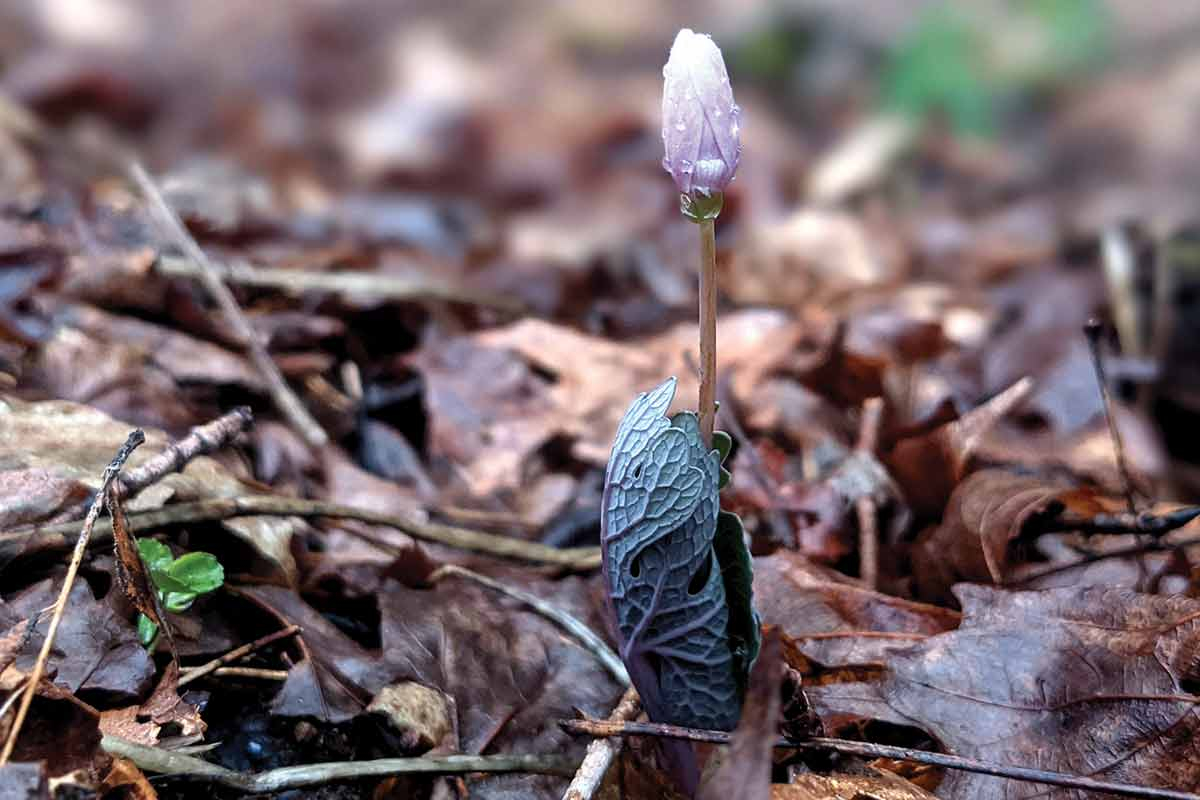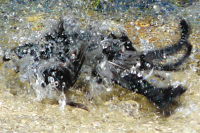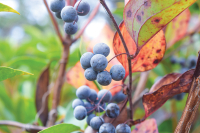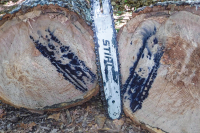It’s in our blood
 Bloodroot is named for the reddish-orange sap that oozes from its rhizome. Adam Bigelow photo
Bloodroot is named for the reddish-orange sap that oozes from its rhizome. Adam Bigelow photo
Each spring I am struck by the beauty and encouraged by the support given by bloodroot (Sanguinaria canadensis) as it emerges and begins its process of opening the flower and unfurling the leaf. The flower bud and leaf come up together, poking through the duff of last year’s tree leaves blanketing the forest floor. Before opening, the flower looks like an egg on the end of a long skinny stalk. This top-heavy flower might just flop over, were it not for the leaf wrapped around the stem, like a helping hand holding the flower for us to see.
Both the common name of bloodroot and the botanical Latin name of Sanguinaria are references to the reddish-orange sap that oozes out of the root, or more correctly from the rhizome. A rhizome is a modified stem that grows underground and sends out both roots and shoots from growth points, or nodes, found along the stem. There are many plants that produce rhizomes, including rivercane (Arundinaria spp.), some ferns and grasses. There are some rhizomes that we eat, like ginger and turmeric.
The rhizome and its blood-like sap have many uses, both historically and currently. It is important to note that bloodroot should not be used as medicine, either topically or internally, unless you are under the care of a knowledgeable medicinal herbalist, as it is a potent and strong medicine. Bloodroot is in the poppy family of plants (Papaveraceae) and like other members of this plant family, including opium poppies, it has potentially toxic alkaloids that can be poisonous to animals, including humans.
Many a kid growing up in Appalachia has memories of digging up bloodroot, snapping open the rhizome to watch the “blood” ooze, and then painting their faces and lips with the sap. I’m going to suggest to not let kids do that anymore. This toxic sap has been used to burn off skin tags and warts, and can have lasting, negative impacts on skin. But that is not to say that we shouldn’t be using bloodroot as a dye. Just not on your person.
Cherokee and other indigenous people of eastern North America have and continue to use the sap of bloodroot as a red dye in basket making, along with yellowroot (Xanthorhiza simplicissima) for yellow color, black walnut (Juglans nigra) for brown and butternut (Juglans cinera) for black. In researching this part of the story, I came across an article by the late George Ellison, a naturalist without compare, from the Dec. 14, 2005, issue of The Smoky Mountain News, online at smokymountainnews.com/archives/item/15308-traditional-cherokee-dyes .)
Once the flower of bloodroot has had enough time to strengthen and grow, it opens into a beautiful, shock-white flower with vivid yellow stamens. The leaf then unfurls from around the stem. Its supporting role finished, it lays out flat above the ground and begins photosynthesizing to capture sunlight. As the season progresses and the tree canopy fills in, blocking sunlight from the forest floor, the bloodroot leaves get larger until they eventually die back in the late summer/early fall.
Related Items
Bloodroot and many other spring wildflowers in Southern Appalachia have developed an interesting method of dispersing their seeds. Each seed of bloodroot develops a fat and protein rich part called an elaiosome that is attached to the seed. Ants, and it turns out yellowjackets, find this elaiosome delicious, and will carry the seeds back to their mounds, eat the elaiosome and toss the seed onto their waste pile. This effectively plants the seed, allowing it to grow. Often you can see a cluster of bloodroot — or trilliums (Trillium spp.), which also have elaiosomes — that are all growing from a central area. This indicates that they were planted by these accidental ant farmers.
Unfortunately, it turns out that imported red fire ants, which have invaded the mountains in the last 10 years, like to eat both the elaiosome and the seed of bloodroot and other spring wildflowers, which will contribute to the decline of wildflower populations, along with the impacts of habitat loss through development and human-caused climate change. However, I remain sanguine that bloodroot and other wildflowers of Southern Appalachia will continue to thrive long after I am gone. Especially if we fall in love with them and protect them. It’s in our blood to do so.
(Adam Bigelow lives in Cullowhee and leads weekly wildflower walks and ecotours through Bigelow’s Botanical Excursions. This email address is being protected from spambots. You need JavaScript enabled to view it..)













